Case Study: Leadership Impact on Employee Engagement at ICICI Bank
VerifiedAdded on 2023/04/26
|52
|11691
|131
Case Study
AI Summary
This case study investigates the impact of leadership on employee engagement and wellbeing within Industrial Credit and Investment Corporation of India (ICICI) Bank. The study uses a descriptive research design and stratified random sampling to survey 51 employees from various levels within the bank's Vinukonda branch. Data was collected through questionnaires and analyzed using descriptive and inferential statistics with SPSS software. The research focuses on how leadership influences employee beliefs about the company and their work environment, their feelings regarding the company and work engagement, and their organizational citizenship behavior (OCB). The findings indicate that leadership significantly affects all three areas, with employees reporting higher levels of engagement and wellbeing under effective leadership. The study concludes with recommendations for developing training programs and adopting appropriate leadership styles to further enhance employee engagement and organizational outcomes. This comprehensive analysis provides valuable insights into the critical role of leadership in fostering a positive and productive work environment within the banking sector.
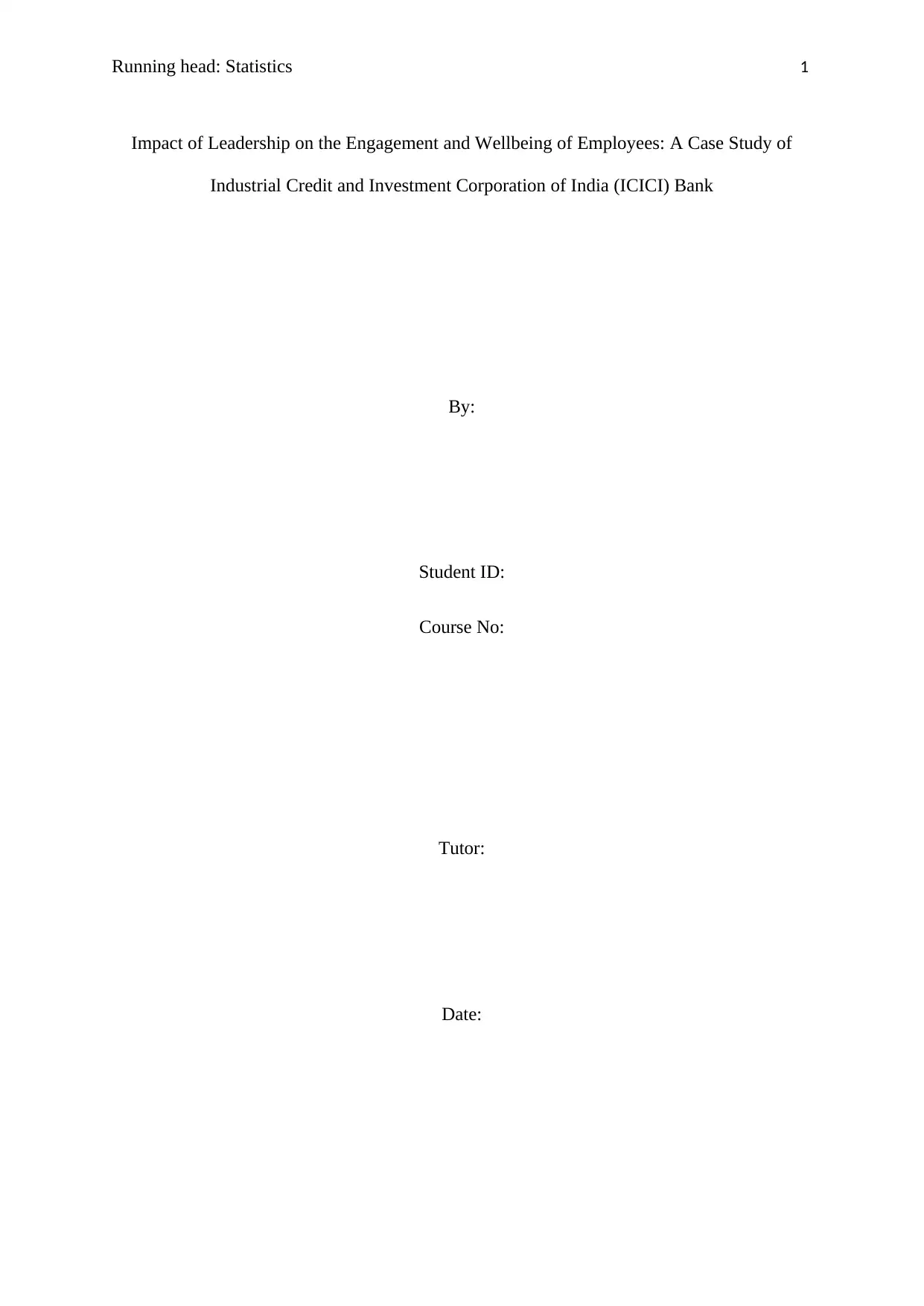
Running head: Statistics 1
Impact of Leadership on the Engagement and Wellbeing of Employees: A Case Study of
Industrial Credit and Investment Corporation of India (ICICI) Bank
By:
Student ID:
Course No:
Tutor:
Date:
Impact of Leadership on the Engagement and Wellbeing of Employees: A Case Study of
Industrial Credit and Investment Corporation of India (ICICI) Bank
By:
Student ID:
Course No:
Tutor:
Date:
Paraphrase This Document
Need a fresh take? Get an instant paraphrase of this document with our AI Paraphraser
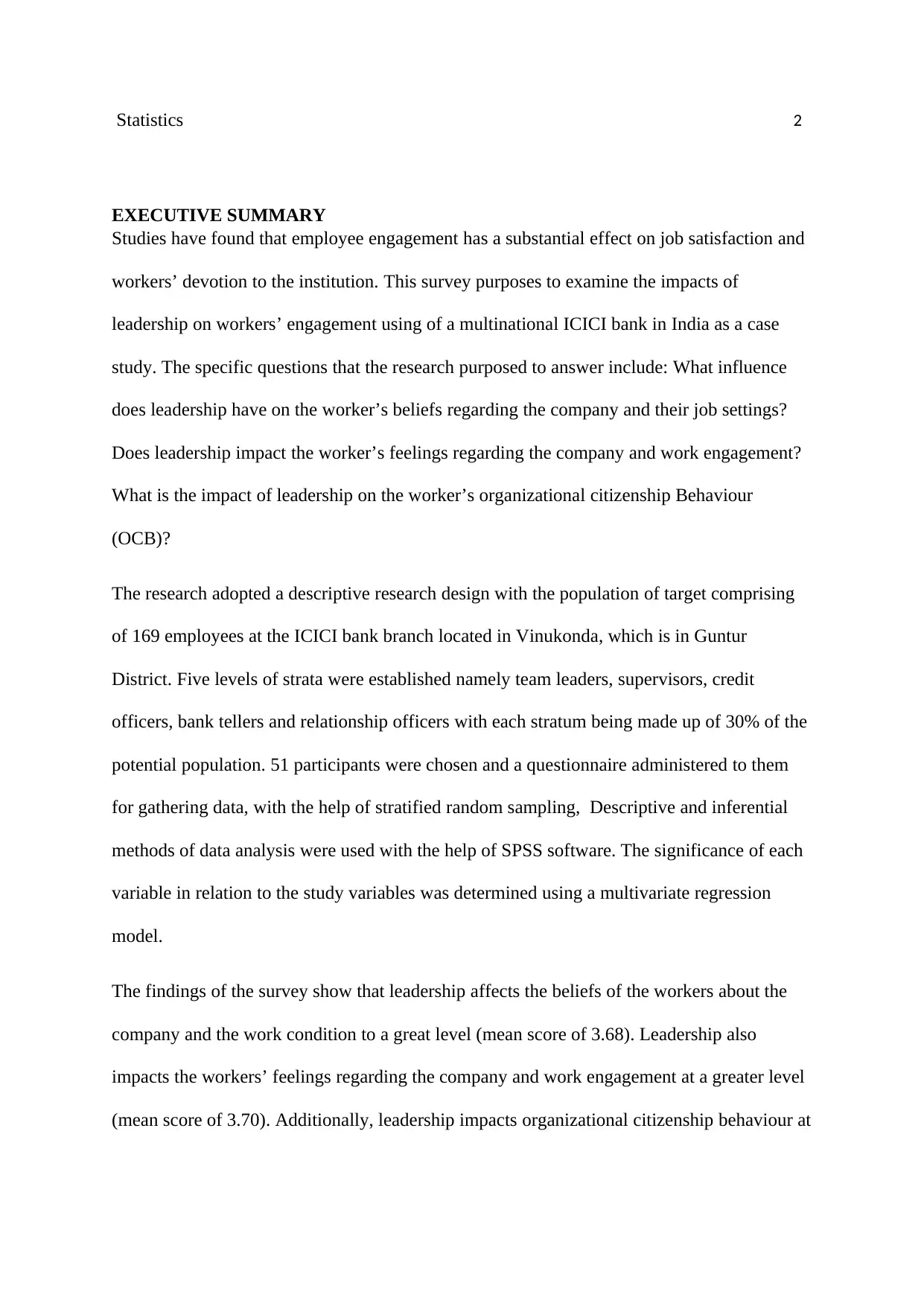
Statistics 2
EXECUTIVE SUMMARY
Studies have found that employee engagement has a substantial effect on job satisfaction and
workers’ devotion to the institution. This survey purposes to examine the impacts of
leadership on workers’ engagement using of a multinational ICICI bank in India as a case
study. The specific questions that the research purposed to answer include: What influence
does leadership have on the worker’s beliefs regarding the company and their job settings?
Does leadership impact the worker’s feelings regarding the company and work engagement?
What is the impact of leadership on the worker’s organizational citizenship Behaviour
(OCB)?
The research adopted a descriptive research design with the population of target comprising
of 169 employees at the ICICI bank branch located in Vinukonda, which is in Guntur
District. Five levels of strata were established namely team leaders, supervisors, credit
officers, bank tellers and relationship officers with each stratum being made up of 30% of the
potential population. 51 participants were chosen and a questionnaire administered to them
for gathering data, with the help of stratified random sampling, Descriptive and inferential
methods of data analysis were used with the help of SPSS software. The significance of each
variable in relation to the study variables was determined using a multivariate regression
model.
The findings of the survey show that leadership affects the beliefs of the workers about the
company and the work condition to a great level (mean score of 3.68). Leadership also
impacts the workers’ feelings regarding the company and work engagement at a greater level
(mean score of 3.70). Additionally, leadership impacts organizational citizenship behaviour at
EXECUTIVE SUMMARY
Studies have found that employee engagement has a substantial effect on job satisfaction and
workers’ devotion to the institution. This survey purposes to examine the impacts of
leadership on workers’ engagement using of a multinational ICICI bank in India as a case
study. The specific questions that the research purposed to answer include: What influence
does leadership have on the worker’s beliefs regarding the company and their job settings?
Does leadership impact the worker’s feelings regarding the company and work engagement?
What is the impact of leadership on the worker’s organizational citizenship Behaviour
(OCB)?
The research adopted a descriptive research design with the population of target comprising
of 169 employees at the ICICI bank branch located in Vinukonda, which is in Guntur
District. Five levels of strata were established namely team leaders, supervisors, credit
officers, bank tellers and relationship officers with each stratum being made up of 30% of the
potential population. 51 participants were chosen and a questionnaire administered to them
for gathering data, with the help of stratified random sampling, Descriptive and inferential
methods of data analysis were used with the help of SPSS software. The significance of each
variable in relation to the study variables was determined using a multivariate regression
model.
The findings of the survey show that leadership affects the beliefs of the workers about the
company and the work condition to a great level (mean score of 3.68). Leadership also
impacts the workers’ feelings regarding the company and work engagement at a greater level
(mean score of 3.70). Additionally, leadership impacts organizational citizenship behaviour at
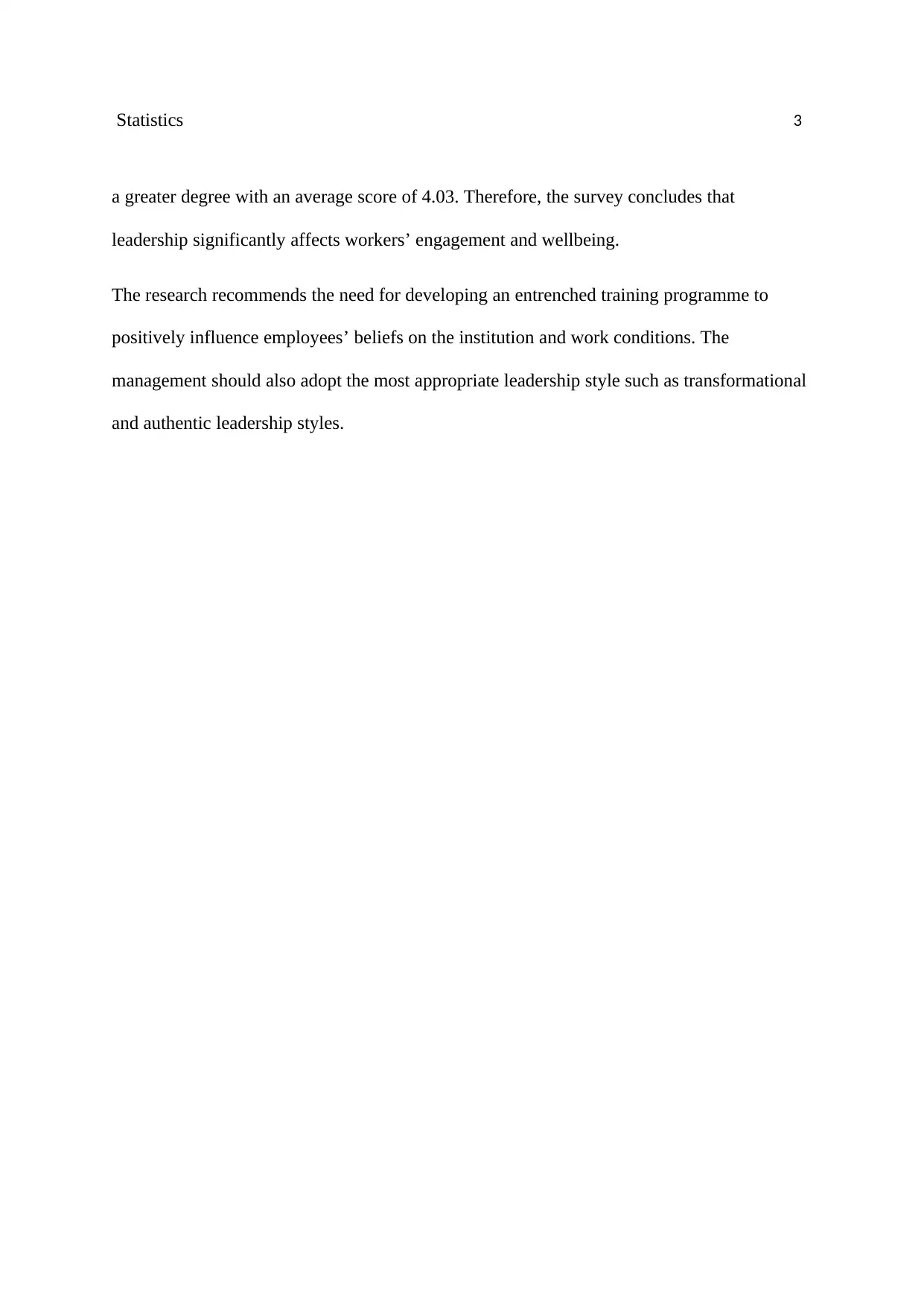
Statistics 3
a greater degree with an average score of 4.03. Therefore, the survey concludes that
leadership significantly affects workers’ engagement and wellbeing.
The research recommends the need for developing an entrenched training programme to
positively influence employees’ beliefs on the institution and work conditions. The
management should also adopt the most appropriate leadership style such as transformational
and authentic leadership styles.
a greater degree with an average score of 4.03. Therefore, the survey concludes that
leadership significantly affects workers’ engagement and wellbeing.
The research recommends the need for developing an entrenched training programme to
positively influence employees’ beliefs on the institution and work conditions. The
management should also adopt the most appropriate leadership style such as transformational
and authentic leadership styles.
⊘ This is a preview!⊘
Do you want full access?
Subscribe today to unlock all pages.

Trusted by 1+ million students worldwide
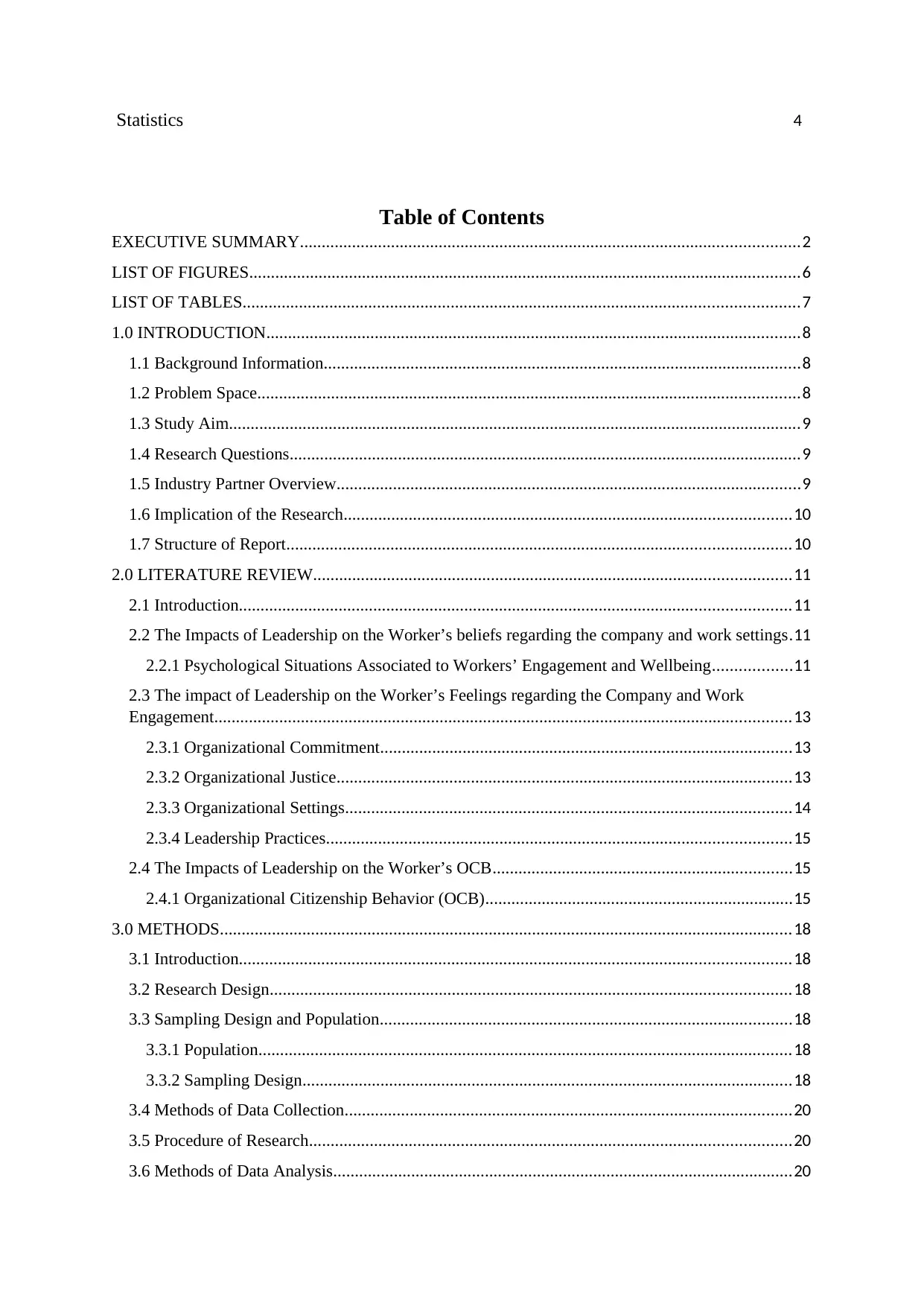
Statistics 4
Table of Contents
EXECUTIVE SUMMARY...................................................................................................................2
LIST OF FIGURES...............................................................................................................................6
LIST OF TABLES................................................................................................................................7
1.0 INTRODUCTION...........................................................................................................................8
1.1 Background Information..............................................................................................................8
1.2 Problem Space.............................................................................................................................8
1.3 Study Aim....................................................................................................................................9
1.4 Research Questions......................................................................................................................9
1.5 Industry Partner Overview...........................................................................................................9
1.6 Implication of the Research.......................................................................................................10
1.7 Structure of Report....................................................................................................................10
2.0 LITERATURE REVIEW..............................................................................................................11
2.1 Introduction...............................................................................................................................11
2.2 The Impacts of Leadership on the Worker’s beliefs regarding the company and work settings.11
2.2.1 Psychological Situations Associated to Workers’ Engagement and Wellbeing..................11
2.3 The impact of Leadership on the Worker’s Feelings regarding the Company and Work
Engagement.....................................................................................................................................13
2.3.1 Organizational Commitment...............................................................................................13
2.3.2 Organizational Justice.........................................................................................................13
2.3.3 Organizational Settings.......................................................................................................14
2.3.4 Leadership Practices...........................................................................................................15
2.4 The Impacts of Leadership on the Worker’s OCB.....................................................................15
2.4.1 Organizational Citizenship Behavior (OCB).......................................................................15
3.0 METHODS....................................................................................................................................18
3.1 Introduction...............................................................................................................................18
3.2 Research Design........................................................................................................................18
3.3 Sampling Design and Population...............................................................................................18
3.3.1 Population...........................................................................................................................18
3.3.2 Sampling Design.................................................................................................................18
3.4 Methods of Data Collection.......................................................................................................20
3.5 Procedure of Research...............................................................................................................20
3.6 Methods of Data Analysis..........................................................................................................20
Table of Contents
EXECUTIVE SUMMARY...................................................................................................................2
LIST OF FIGURES...............................................................................................................................6
LIST OF TABLES................................................................................................................................7
1.0 INTRODUCTION...........................................................................................................................8
1.1 Background Information..............................................................................................................8
1.2 Problem Space.............................................................................................................................8
1.3 Study Aim....................................................................................................................................9
1.4 Research Questions......................................................................................................................9
1.5 Industry Partner Overview...........................................................................................................9
1.6 Implication of the Research.......................................................................................................10
1.7 Structure of Report....................................................................................................................10
2.0 LITERATURE REVIEW..............................................................................................................11
2.1 Introduction...............................................................................................................................11
2.2 The Impacts of Leadership on the Worker’s beliefs regarding the company and work settings.11
2.2.1 Psychological Situations Associated to Workers’ Engagement and Wellbeing..................11
2.3 The impact of Leadership on the Worker’s Feelings regarding the Company and Work
Engagement.....................................................................................................................................13
2.3.1 Organizational Commitment...............................................................................................13
2.3.2 Organizational Justice.........................................................................................................13
2.3.3 Organizational Settings.......................................................................................................14
2.3.4 Leadership Practices...........................................................................................................15
2.4 The Impacts of Leadership on the Worker’s OCB.....................................................................15
2.4.1 Organizational Citizenship Behavior (OCB).......................................................................15
3.0 METHODS....................................................................................................................................18
3.1 Introduction...............................................................................................................................18
3.2 Research Design........................................................................................................................18
3.3 Sampling Design and Population...............................................................................................18
3.3.1 Population...........................................................................................................................18
3.3.2 Sampling Design.................................................................................................................18
3.4 Methods of Data Collection.......................................................................................................20
3.5 Procedure of Research...............................................................................................................20
3.6 Methods of Data Analysis..........................................................................................................20
Paraphrase This Document
Need a fresh take? Get an instant paraphrase of this document with our AI Paraphraser
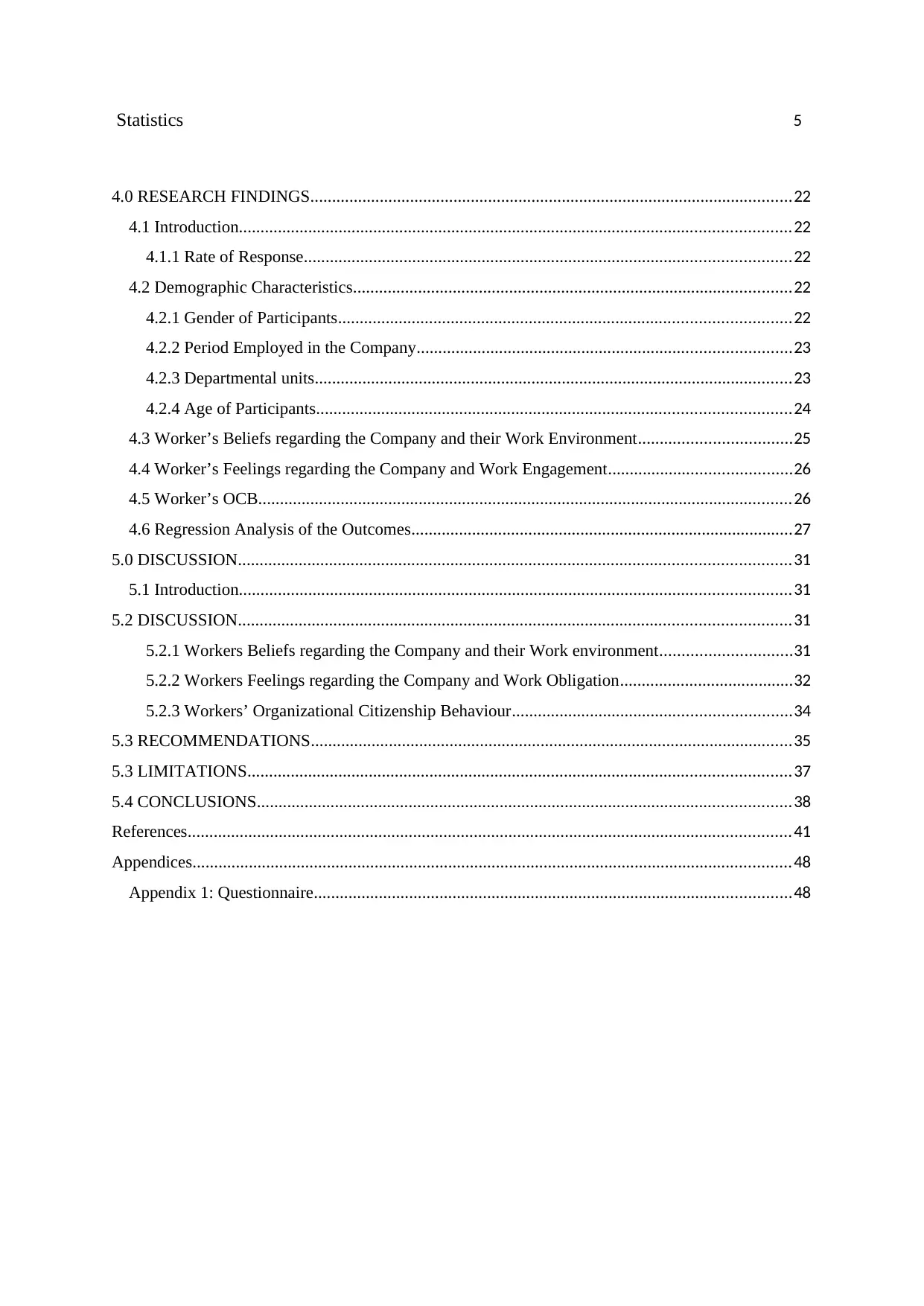
Statistics 5
4.0 RESEARCH FINDINGS...............................................................................................................22
4.1 Introduction...............................................................................................................................22
4.1.1 Rate of Response................................................................................................................22
4.2 Demographic Characteristics.....................................................................................................22
4.2.1 Gender of Participants........................................................................................................22
4.2.2 Period Employed in the Company......................................................................................23
4.2.3 Departmental units..............................................................................................................23
4.2.4 Age of Participants.............................................................................................................24
4.3 Worker’s Beliefs regarding the Company and their Work Environment...................................25
4.4 Worker’s Feelings regarding the Company and Work Engagement..........................................26
4.5 Worker’s OCB...........................................................................................................................26
4.6 Regression Analysis of the Outcomes........................................................................................27
5.0 DISCUSSION...............................................................................................................................31
5.1 Introduction...............................................................................................................................31
5.2 DISCUSSION...............................................................................................................................31
5.2.1 Workers Beliefs regarding the Company and their Work environment..............................31
5.2.2 Workers Feelings regarding the Company and Work Obligation........................................32
5.2.3 Workers’ Organizational Citizenship Behaviour................................................................34
5.3 RECOMMENDATIONS...............................................................................................................35
5.3 LIMITATIONS.............................................................................................................................37
5.4 CONCLUSIONS...........................................................................................................................38
References...........................................................................................................................................41
Appendices..........................................................................................................................................48
Appendix 1: Questionnaire..............................................................................................................48
4.0 RESEARCH FINDINGS...............................................................................................................22
4.1 Introduction...............................................................................................................................22
4.1.1 Rate of Response................................................................................................................22
4.2 Demographic Characteristics.....................................................................................................22
4.2.1 Gender of Participants........................................................................................................22
4.2.2 Period Employed in the Company......................................................................................23
4.2.3 Departmental units..............................................................................................................23
4.2.4 Age of Participants.............................................................................................................24
4.3 Worker’s Beliefs regarding the Company and their Work Environment...................................25
4.4 Worker’s Feelings regarding the Company and Work Engagement..........................................26
4.5 Worker’s OCB...........................................................................................................................26
4.6 Regression Analysis of the Outcomes........................................................................................27
5.0 DISCUSSION...............................................................................................................................31
5.1 Introduction...............................................................................................................................31
5.2 DISCUSSION...............................................................................................................................31
5.2.1 Workers Beliefs regarding the Company and their Work environment..............................31
5.2.2 Workers Feelings regarding the Company and Work Obligation........................................32
5.2.3 Workers’ Organizational Citizenship Behaviour................................................................34
5.3 RECOMMENDATIONS...............................................................................................................35
5.3 LIMITATIONS.............................................................................................................................37
5.4 CONCLUSIONS...........................................................................................................................38
References...........................................................................................................................................41
Appendices..........................................................................................................................................48
Appendix 1: Questionnaire..............................................................................................................48
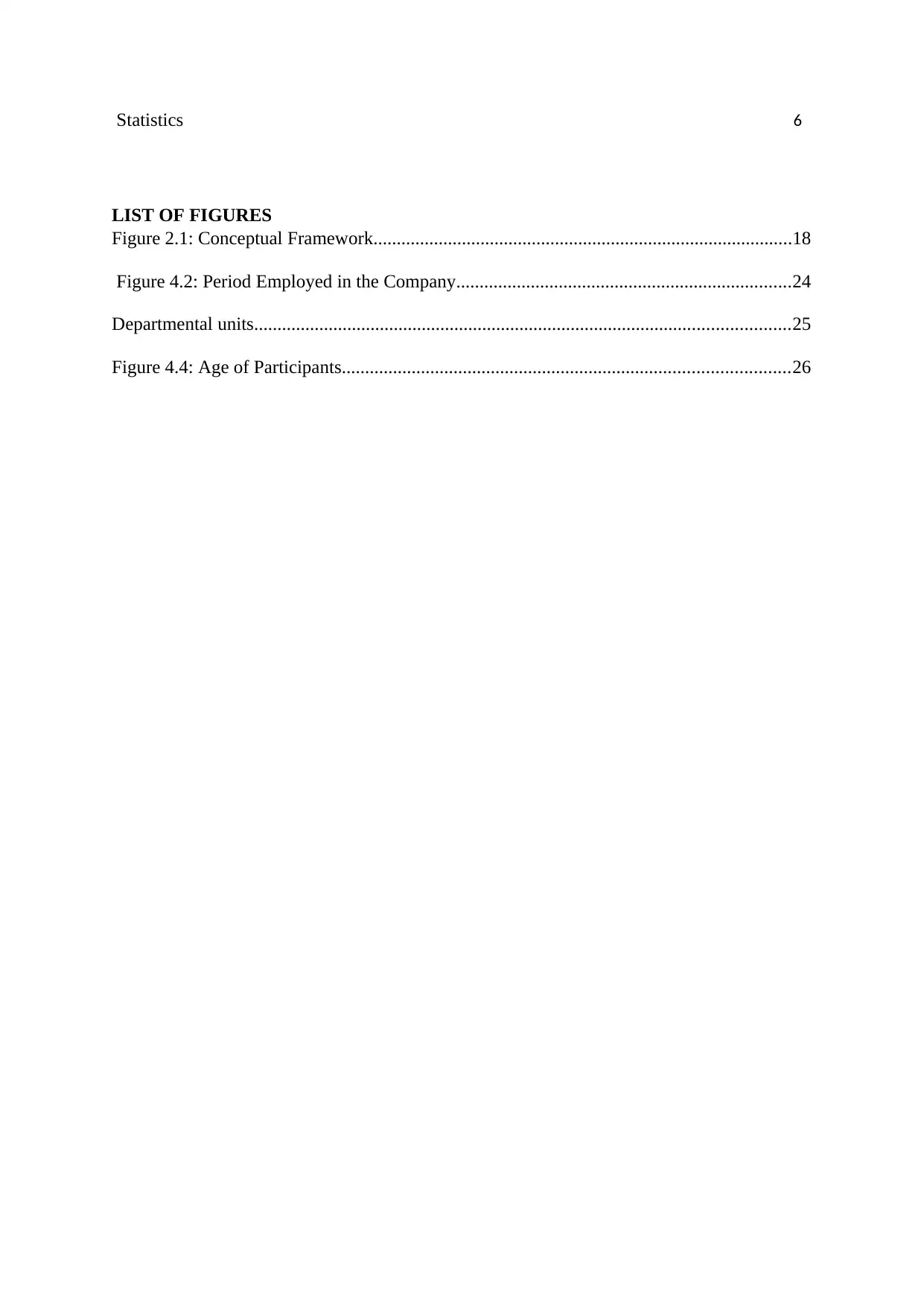
Statistics 6
LIST OF FIGURES
Figure 2.1: Conceptual Framework..........................................................................................18
Figure 4.2: Period Employed in the Company........................................................................24
Departmental units...................................................................................................................25
Figure 4.4: Age of Participants................................................................................................26
LIST OF FIGURES
Figure 2.1: Conceptual Framework..........................................................................................18
Figure 4.2: Period Employed in the Company........................................................................24
Departmental units...................................................................................................................25
Figure 4.4: Age of Participants................................................................................................26
⊘ This is a preview!⊘
Do you want full access?
Subscribe today to unlock all pages.

Trusted by 1+ million students worldwide
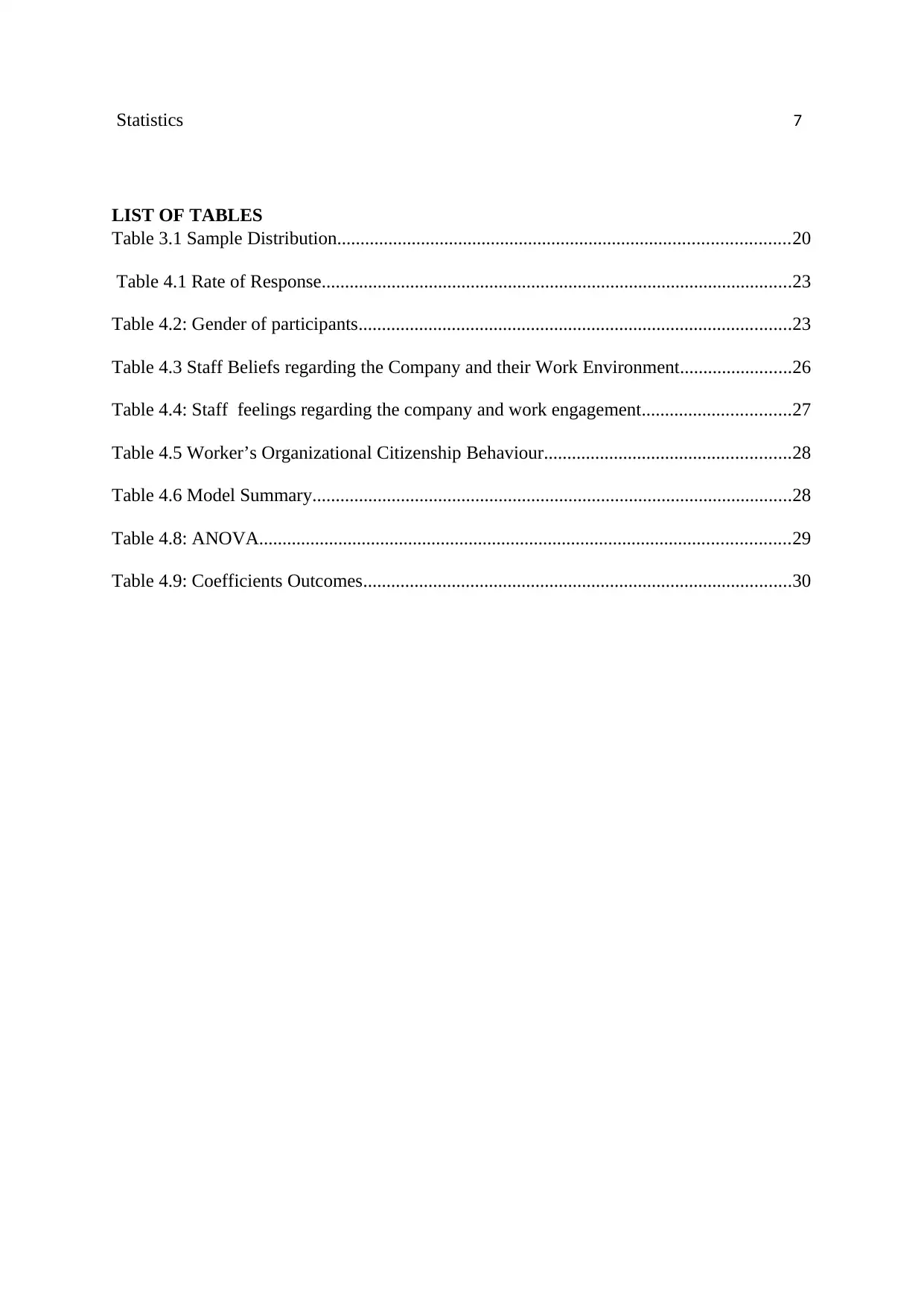
Statistics 7
LIST OF TABLES
Table 3.1 Sample Distribution.................................................................................................20
Table 4.1 Rate of Response.....................................................................................................23
Table 4.2: Gender of participants.............................................................................................23
Table 4.3 Staff Beliefs regarding the Company and their Work Environment........................26
Table 4.4: Staff feelings regarding the company and work engagement................................27
Table 4.5 Worker’s Organizational Citizenship Behaviour.....................................................28
Table 4.6 Model Summary.......................................................................................................28
Table 4.8: ANOVA..................................................................................................................29
Table 4.9: Coefficients Outcomes............................................................................................30
LIST OF TABLES
Table 3.1 Sample Distribution.................................................................................................20
Table 4.1 Rate of Response.....................................................................................................23
Table 4.2: Gender of participants.............................................................................................23
Table 4.3 Staff Beliefs regarding the Company and their Work Environment........................26
Table 4.4: Staff feelings regarding the company and work engagement................................27
Table 4.5 Worker’s Organizational Citizenship Behaviour.....................................................28
Table 4.6 Model Summary.......................................................................................................28
Table 4.8: ANOVA..................................................................................................................29
Table 4.9: Coefficients Outcomes............................................................................................30
Paraphrase This Document
Need a fresh take? Get an instant paraphrase of this document with our AI Paraphraser
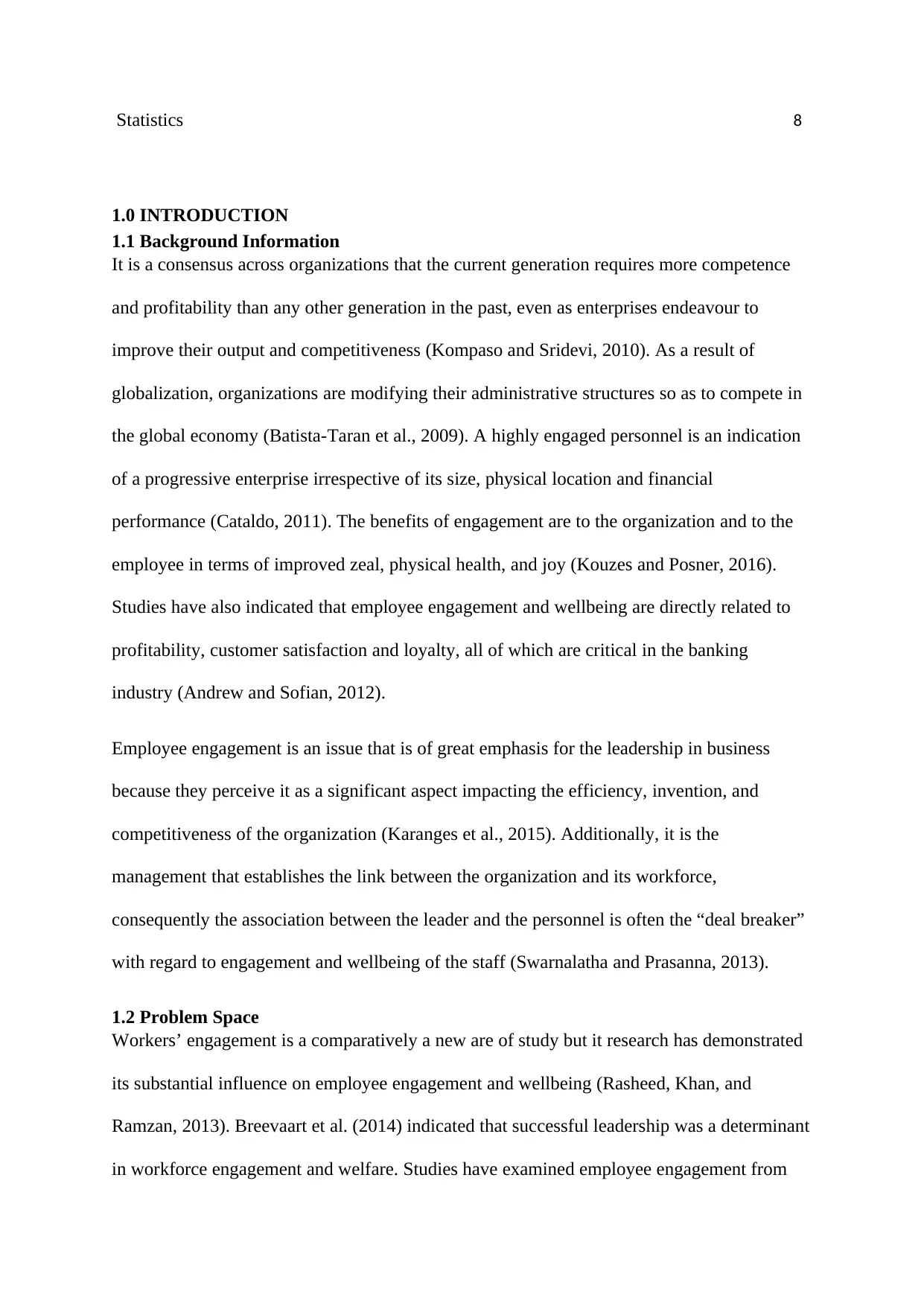
Statistics 8
1.0 INTRODUCTION
1.1 Background Information
It is a consensus across organizations that the current generation requires more competence
and profitability than any other generation in the past, even as enterprises endeavour to
improve their output and competitiveness (Kompaso and Sridevi, 2010). As a result of
globalization, organizations are modifying their administrative structures so as to compete in
the global economy (Batista-Taran et al., 2009). A highly engaged personnel is an indication
of a progressive enterprise irrespective of its size, physical location and financial
performance (Cataldo, 2011). The benefits of engagement are to the organization and to the
employee in terms of improved zeal, physical health, and joy (Kouzes and Posner, 2016).
Studies have also indicated that employee engagement and wellbeing are directly related to
profitability, customer satisfaction and loyalty, all of which are critical in the banking
industry (Andrew and Sofian, 2012).
Employee engagement is an issue that is of great emphasis for the leadership in business
because they perceive it as a significant aspect impacting the efficiency, invention, and
competitiveness of the organization (Karanges et al., 2015). Additionally, it is the
management that establishes the link between the organization and its workforce,
consequently the association between the leader and the personnel is often the “deal breaker”
with regard to engagement and wellbeing of the staff (Swarnalatha and Prasanna, 2013).
1.2 Problem Space
Workers’ engagement is a comparatively a new are of study but it research has demonstrated
its substantial influence on employee engagement and wellbeing (Rasheed, Khan, and
Ramzan, 2013). Breevaart et al. (2014) indicated that successful leadership was a determinant
in workforce engagement and welfare. Studies have examined employee engagement from
1.0 INTRODUCTION
1.1 Background Information
It is a consensus across organizations that the current generation requires more competence
and profitability than any other generation in the past, even as enterprises endeavour to
improve their output and competitiveness (Kompaso and Sridevi, 2010). As a result of
globalization, organizations are modifying their administrative structures so as to compete in
the global economy (Batista-Taran et al., 2009). A highly engaged personnel is an indication
of a progressive enterprise irrespective of its size, physical location and financial
performance (Cataldo, 2011). The benefits of engagement are to the organization and to the
employee in terms of improved zeal, physical health, and joy (Kouzes and Posner, 2016).
Studies have also indicated that employee engagement and wellbeing are directly related to
profitability, customer satisfaction and loyalty, all of which are critical in the banking
industry (Andrew and Sofian, 2012).
Employee engagement is an issue that is of great emphasis for the leadership in business
because they perceive it as a significant aspect impacting the efficiency, invention, and
competitiveness of the organization (Karanges et al., 2015). Additionally, it is the
management that establishes the link between the organization and its workforce,
consequently the association between the leader and the personnel is often the “deal breaker”
with regard to engagement and wellbeing of the staff (Swarnalatha and Prasanna, 2013).
1.2 Problem Space
Workers’ engagement is a comparatively a new are of study but it research has demonstrated
its substantial influence on employee engagement and wellbeing (Rasheed, Khan, and
Ramzan, 2013). Breevaart et al. (2014) indicated that successful leadership was a determinant
in workforce engagement and welfare. Studies have examined employee engagement from
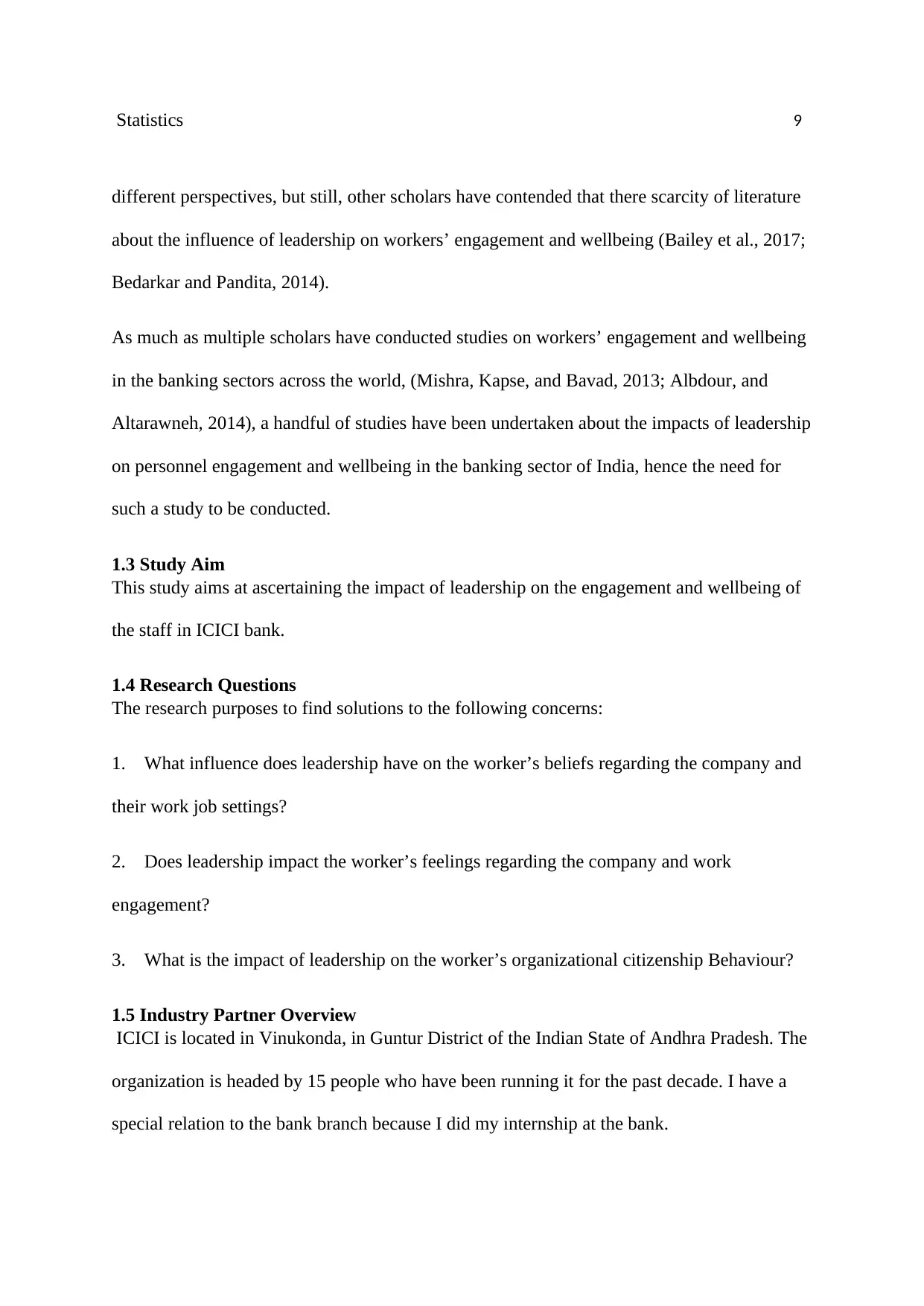
Statistics 9
different perspectives, but still, other scholars have contended that there scarcity of literature
about the influence of leadership on workers’ engagement and wellbeing (Bailey et al., 2017;
Bedarkar and Pandita, 2014).
As much as multiple scholars have conducted studies on workers’ engagement and wellbeing
in the banking sectors across the world, (Mishra, Kapse, and Bavad, 2013; Albdour, and
Altarawneh, 2014), a handful of studies have been undertaken about the impacts of leadership
on personnel engagement and wellbeing in the banking sector of India, hence the need for
such a study to be conducted.
1.3 Study Aim
This study aims at ascertaining the impact of leadership on the engagement and wellbeing of
the staff in ICICI bank.
1.4 Research Questions
The research purposes to find solutions to the following concerns:
1. What influence does leadership have on the worker’s beliefs regarding the company and
their work job settings?
2. Does leadership impact the worker’s feelings regarding the company and work
engagement?
3. What is the impact of leadership on the worker’s organizational citizenship Behaviour?
1.5 Industry Partner Overview
ICICI is located in Vinukonda, in Guntur District of the Indian State of Andhra Pradesh. The
organization is headed by 15 people who have been running it for the past decade. I have a
special relation to the bank branch because I did my internship at the bank.
different perspectives, but still, other scholars have contended that there scarcity of literature
about the influence of leadership on workers’ engagement and wellbeing (Bailey et al., 2017;
Bedarkar and Pandita, 2014).
As much as multiple scholars have conducted studies on workers’ engagement and wellbeing
in the banking sectors across the world, (Mishra, Kapse, and Bavad, 2013; Albdour, and
Altarawneh, 2014), a handful of studies have been undertaken about the impacts of leadership
on personnel engagement and wellbeing in the banking sector of India, hence the need for
such a study to be conducted.
1.3 Study Aim
This study aims at ascertaining the impact of leadership on the engagement and wellbeing of
the staff in ICICI bank.
1.4 Research Questions
The research purposes to find solutions to the following concerns:
1. What influence does leadership have on the worker’s beliefs regarding the company and
their work job settings?
2. Does leadership impact the worker’s feelings regarding the company and work
engagement?
3. What is the impact of leadership on the worker’s organizational citizenship Behaviour?
1.5 Industry Partner Overview
ICICI is located in Vinukonda, in Guntur District of the Indian State of Andhra Pradesh. The
organization is headed by 15 people who have been running it for the past decade. I have a
special relation to the bank branch because I did my internship at the bank.
⊘ This is a preview!⊘
Do you want full access?
Subscribe today to unlock all pages.

Trusted by 1+ million students worldwide
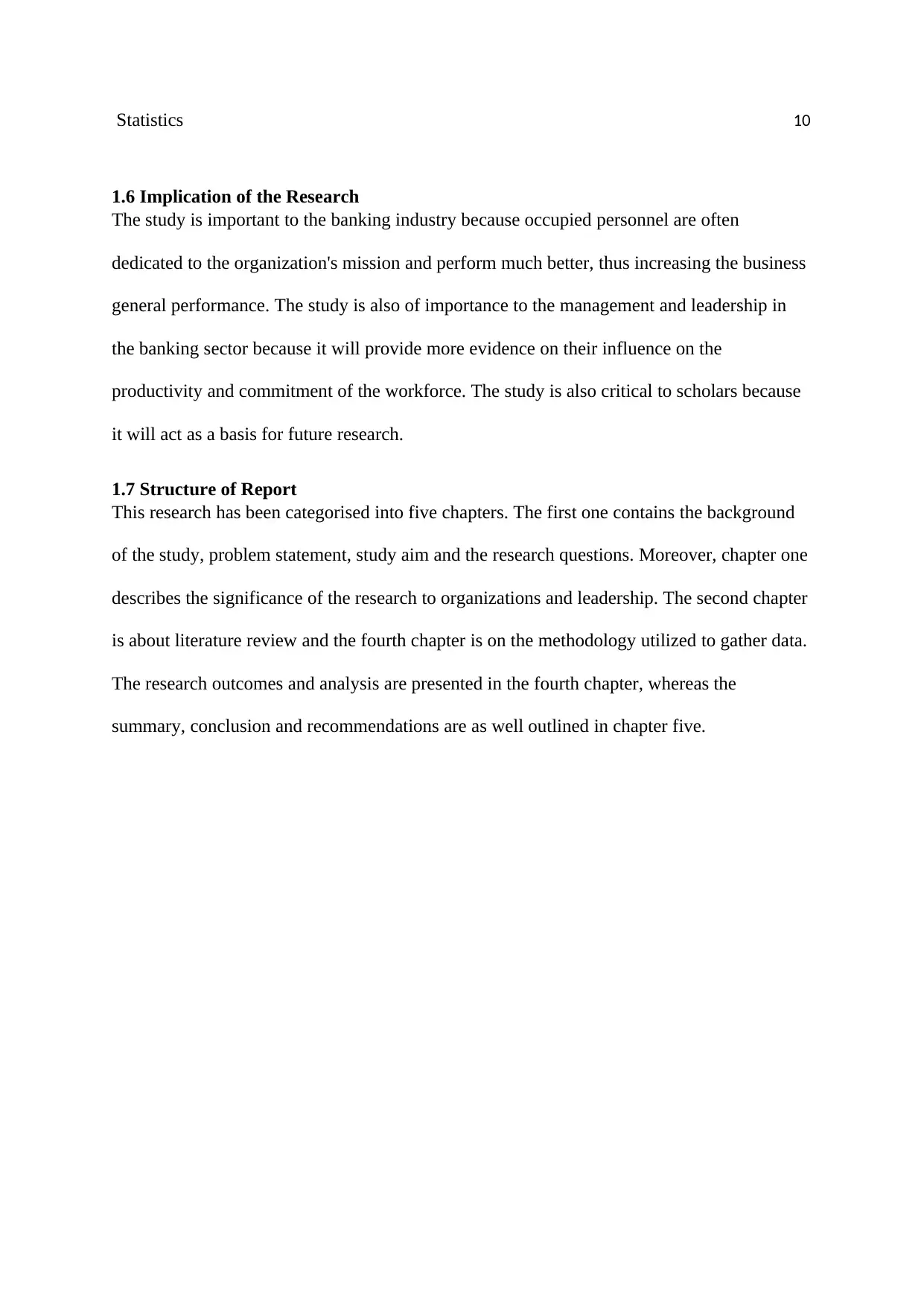
Statistics 10
1.6 Implication of the Research
The study is important to the banking industry because occupied personnel are often
dedicated to the organization's mission and perform much better, thus increasing the business
general performance. The study is also of importance to the management and leadership in
the banking sector because it will provide more evidence on their influence on the
productivity and commitment of the workforce. The study is also critical to scholars because
it will act as a basis for future research.
1.7 Structure of Report
This research has been categorised into five chapters. The first one contains the background
of the study, problem statement, study aim and the research questions. Moreover, chapter one
describes the significance of the research to organizations and leadership. The second chapter
is about literature review and the fourth chapter is on the methodology utilized to gather data.
The research outcomes and analysis are presented in the fourth chapter, whereas the
summary, conclusion and recommendations are as well outlined in chapter five.
1.6 Implication of the Research
The study is important to the banking industry because occupied personnel are often
dedicated to the organization's mission and perform much better, thus increasing the business
general performance. The study is also of importance to the management and leadership in
the banking sector because it will provide more evidence on their influence on the
productivity and commitment of the workforce. The study is also critical to scholars because
it will act as a basis for future research.
1.7 Structure of Report
This research has been categorised into five chapters. The first one contains the background
of the study, problem statement, study aim and the research questions. Moreover, chapter one
describes the significance of the research to organizations and leadership. The second chapter
is about literature review and the fourth chapter is on the methodology utilized to gather data.
The research outcomes and analysis are presented in the fourth chapter, whereas the
summary, conclusion and recommendations are as well outlined in chapter five.
Paraphrase This Document
Need a fresh take? Get an instant paraphrase of this document with our AI Paraphraser
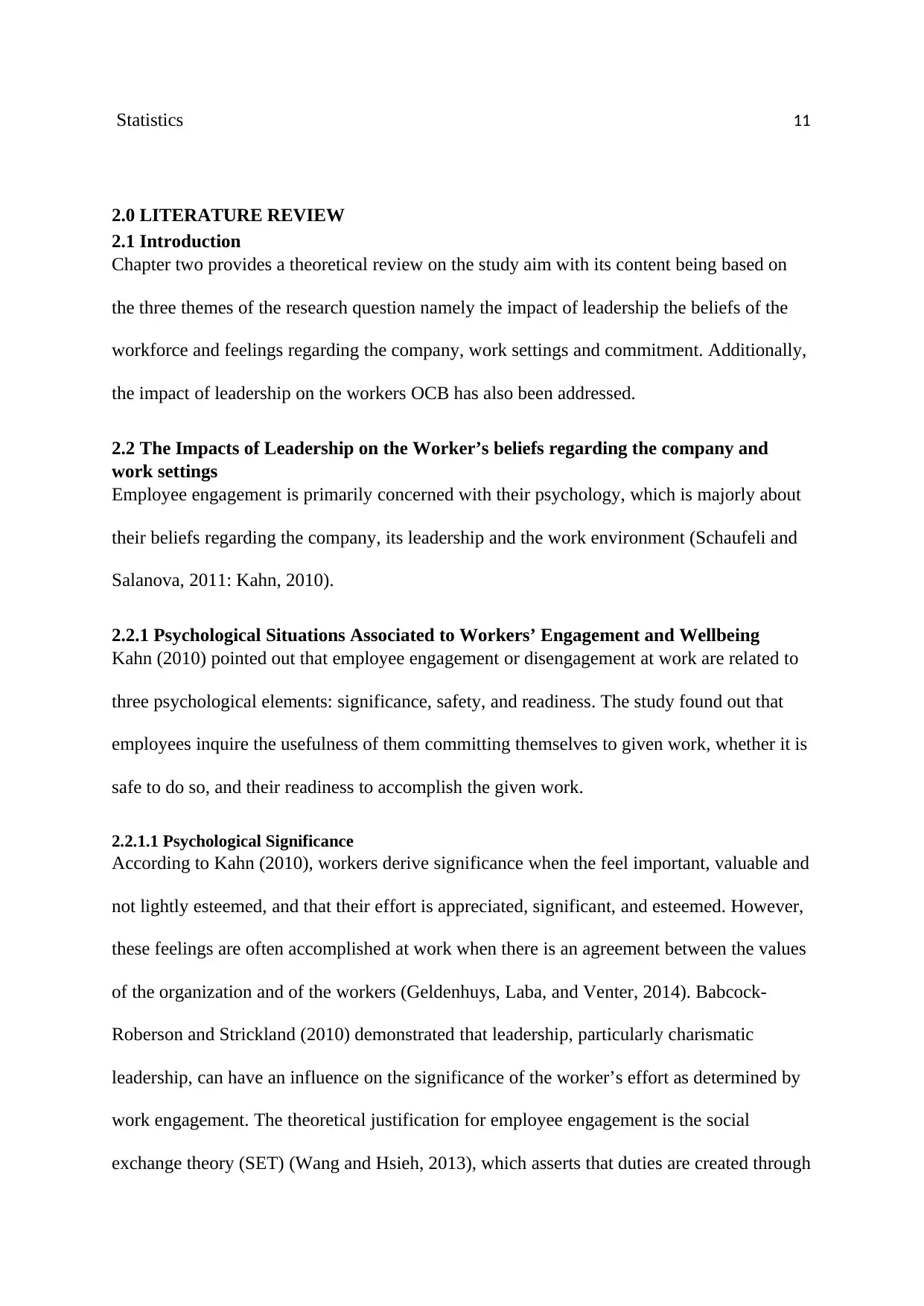
Statistics 11
2.0 LITERATURE REVIEW
2.1 Introduction
Chapter two provides a theoretical review on the study aim with its content being based on
the three themes of the research question namely the impact of leadership the beliefs of the
workforce and feelings regarding the company, work settings and commitment. Additionally,
the impact of leadership on the workers OCB has also been addressed.
2.2 The Impacts of Leadership on the Worker’s beliefs regarding the company and
work settings
Employee engagement is primarily concerned with their psychology, which is majorly about
their beliefs regarding the company, its leadership and the work environment (Schaufeli and
Salanova, 2011: Kahn, 2010).
2.2.1 Psychological Situations Associated to Workers’ Engagement and Wellbeing
Kahn (2010) pointed out that employee engagement or disengagement at work are related to
three psychological elements: significance, safety, and readiness. The study found out that
employees inquire the usefulness of them committing themselves to given work, whether it is
safe to do so, and their readiness to accomplish the given work.
2.2.1.1 Psychological Significance
According to Kahn (2010), workers derive significance when the feel important, valuable and
not lightly esteemed, and that their effort is appreciated, significant, and esteemed. However,
these feelings are often accomplished at work when there is an agreement between the values
of the organization and of the workers (Geldenhuys, Laba, and Venter, 2014). Babcock-
Roberson and Strickland (2010) demonstrated that leadership, particularly charismatic
leadership, can have an influence on the significance of the worker’s effort as determined by
work engagement. The theoretical justification for employee engagement is the social
exchange theory (SET) (Wang and Hsieh, 2013), which asserts that duties are created through
2.0 LITERATURE REVIEW
2.1 Introduction
Chapter two provides a theoretical review on the study aim with its content being based on
the three themes of the research question namely the impact of leadership the beliefs of the
workforce and feelings regarding the company, work settings and commitment. Additionally,
the impact of leadership on the workers OCB has also been addressed.
2.2 The Impacts of Leadership on the Worker’s beliefs regarding the company and
work settings
Employee engagement is primarily concerned with their psychology, which is majorly about
their beliefs regarding the company, its leadership and the work environment (Schaufeli and
Salanova, 2011: Kahn, 2010).
2.2.1 Psychological Situations Associated to Workers’ Engagement and Wellbeing
Kahn (2010) pointed out that employee engagement or disengagement at work are related to
three psychological elements: significance, safety, and readiness. The study found out that
employees inquire the usefulness of them committing themselves to given work, whether it is
safe to do so, and their readiness to accomplish the given work.
2.2.1.1 Psychological Significance
According to Kahn (2010), workers derive significance when the feel important, valuable and
not lightly esteemed, and that their effort is appreciated, significant, and esteemed. However,
these feelings are often accomplished at work when there is an agreement between the values
of the organization and of the workers (Geldenhuys, Laba, and Venter, 2014). Babcock-
Roberson and Strickland (2010) demonstrated that leadership, particularly charismatic
leadership, can have an influence on the significance of the worker’s effort as determined by
work engagement. The theoretical justification for employee engagement is the social
exchange theory (SET) (Wang and Hsieh, 2013), which asserts that duties are created through
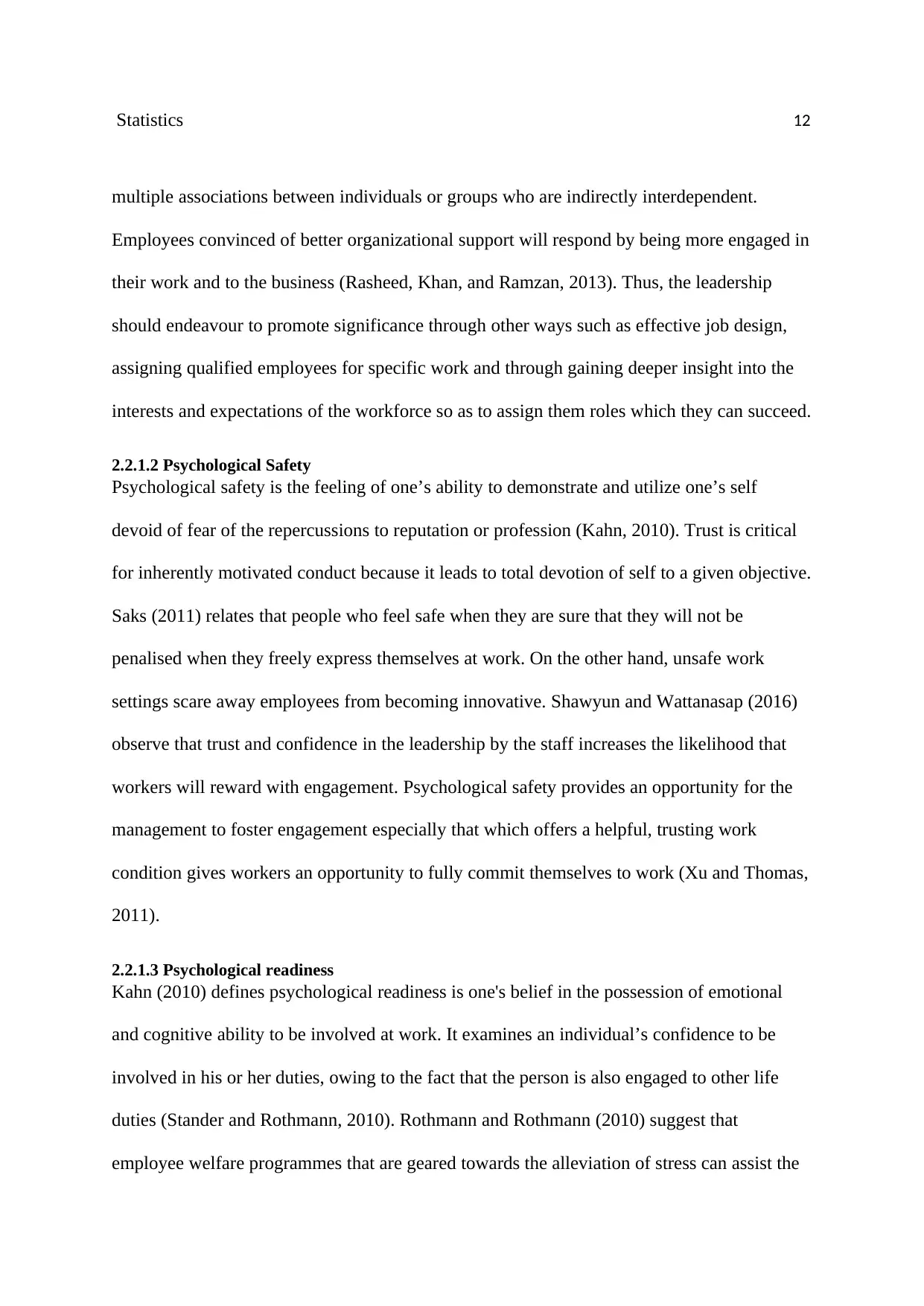
Statistics 12
multiple associations between individuals or groups who are indirectly interdependent.
Employees convinced of better organizational support will respond by being more engaged in
their work and to the business (Rasheed, Khan, and Ramzan, 2013). Thus, the leadership
should endeavour to promote significance through other ways such as effective job design,
assigning qualified employees for specific work and through gaining deeper insight into the
interests and expectations of the workforce so as to assign them roles which they can succeed.
2.2.1.2 Psychological Safety
Psychological safety is the feeling of one’s ability to demonstrate and utilize one’s self
devoid of fear of the repercussions to reputation or profession (Kahn, 2010). Trust is critical
for inherently motivated conduct because it leads to total devotion of self to a given objective.
Saks (2011) relates that people who feel safe when they are sure that they will not be
penalised when they freely express themselves at work. On the other hand, unsafe work
settings scare away employees from becoming innovative. Shawyun and Wattanasap (2016)
observe that trust and confidence in the leadership by the staff increases the likelihood that
workers will reward with engagement. Psychological safety provides an opportunity for the
management to foster engagement especially that which offers a helpful, trusting work
condition gives workers an opportunity to fully commit themselves to work (Xu and Thomas,
2011).
2.2.1.3 Psychological readiness
Kahn (2010) defines psychological readiness is one's belief in the possession of emotional
and cognitive ability to be involved at work. It examines an individual’s confidence to be
involved in his or her duties, owing to the fact that the person is also engaged to other life
duties (Stander and Rothmann, 2010). Rothmann and Rothmann (2010) suggest that
employee welfare programmes that are geared towards the alleviation of stress can assist the
multiple associations between individuals or groups who are indirectly interdependent.
Employees convinced of better organizational support will respond by being more engaged in
their work and to the business (Rasheed, Khan, and Ramzan, 2013). Thus, the leadership
should endeavour to promote significance through other ways such as effective job design,
assigning qualified employees for specific work and through gaining deeper insight into the
interests and expectations of the workforce so as to assign them roles which they can succeed.
2.2.1.2 Psychological Safety
Psychological safety is the feeling of one’s ability to demonstrate and utilize one’s self
devoid of fear of the repercussions to reputation or profession (Kahn, 2010). Trust is critical
for inherently motivated conduct because it leads to total devotion of self to a given objective.
Saks (2011) relates that people who feel safe when they are sure that they will not be
penalised when they freely express themselves at work. On the other hand, unsafe work
settings scare away employees from becoming innovative. Shawyun and Wattanasap (2016)
observe that trust and confidence in the leadership by the staff increases the likelihood that
workers will reward with engagement. Psychological safety provides an opportunity for the
management to foster engagement especially that which offers a helpful, trusting work
condition gives workers an opportunity to fully commit themselves to work (Xu and Thomas,
2011).
2.2.1.3 Psychological readiness
Kahn (2010) defines psychological readiness is one's belief in the possession of emotional
and cognitive ability to be involved at work. It examines an individual’s confidence to be
involved in his or her duties, owing to the fact that the person is also engaged to other life
duties (Stander and Rothmann, 2010). Rothmann and Rothmann (2010) suggest that
employee welfare programmes that are geared towards the alleviation of stress can assist the
⊘ This is a preview!⊘
Do you want full access?
Subscribe today to unlock all pages.

Trusted by 1+ million students worldwide
1 out of 52
Related Documents
Your All-in-One AI-Powered Toolkit for Academic Success.
+13062052269
info@desklib.com
Available 24*7 on WhatsApp / Email
![[object Object]](/_next/static/media/star-bottom.7253800d.svg)
Unlock your academic potential
Copyright © 2020–2025 A2Z Services. All Rights Reserved. Developed and managed by ZUCOL.




